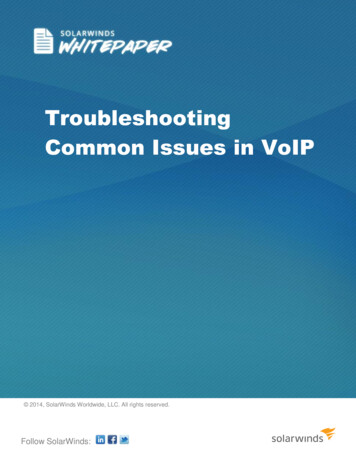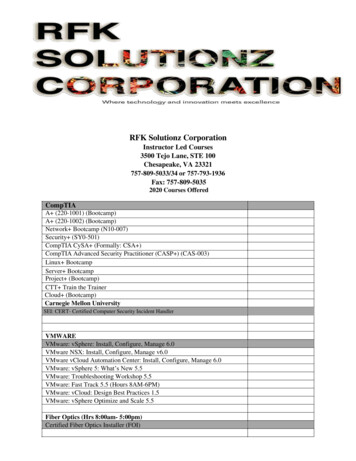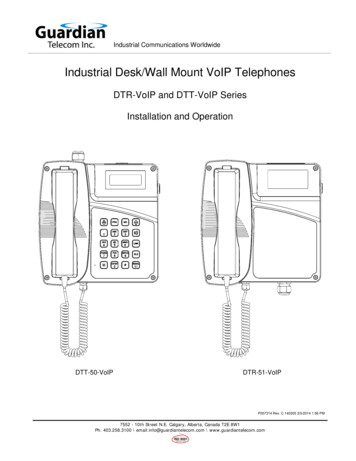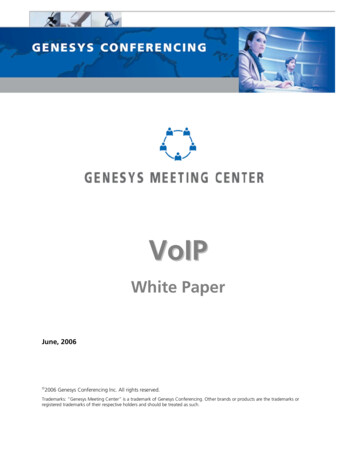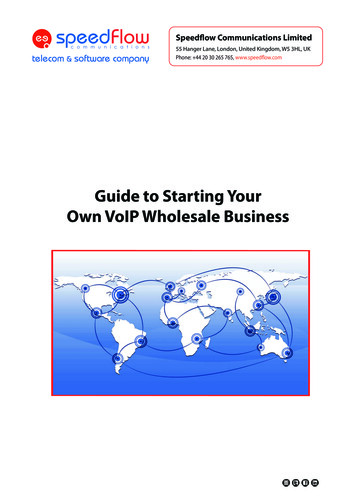
Transcription
Available for Public Use2022 FCC Form 499-A Webinar SeriesOverview for VoIP ProvidersFebruary 18, 2022
Available for Public UseDISCLAIMERTo accommodate all attendees, real-time closed captions will be presentduring this presentation. This is a new feature we are testing out to improvewebinar accessibility for all. We understand it is a significant change andappreciate your patience. We apologize in advance for any transcriptionerrors or distractions. Thank you for your support.2
Available for Public UseHousekeeping The audience will remain on mute Enter questions at any time using the “Questions” box If your audio or slides freeze, restart the webinar A copy of the slide deck is available in the “handouts” section of thewebinar control panel This webinar will be recorded and available on the Services Providers:Webinar webpage3
Available for Public UseMeet Our PresenterAmy KavelmanSenior Telecom Industry Analyst Contributor OperationsMs Kavelman is a member of the 499 review team, responsible for reviewing all ofthe FCC Form 499-As submitted to USAC. She is also responsible for developing anddelivering training for service providers. Amy has worked at USAC for eleven years.4
Available for Public UseWebinar Overview This webinar is intended forproviders of VoIP services. We will cover the mostcommon line numbers usedby VoIP service providerswhen completing their FCCForm 499-A revenuereporting.5
Available for Public UseAgenda Revenue Distinction Reseller vs. End User Interstate & International Service Specific Lines Common Revenue Lines Wrap-Up6
Available for Public UseRevenue ReportingBasics for Reporting Revenue on the FCC Form 499-A7
Available for Public UseRecord Keeping Filers must maintain records and documentation to justify information reporting on the FCC Form499-A Worksheet, including the methodology used to determine projections and to allocateinterstate revenues, for five years. The FCC is added language to the 2020 form instructions to indicate that failure to “submitsupporting documentation” when requested is subject to enforcement action andadministrative penalties. USAC may ask you to provide the reports used by the filer that were used to determine the revenuenumbers reported on the annual Form 499-A. Example: 4,000 is reported as being collected as FUSF on Line 403. What report did you getthat number from? You may be asked to provide it. Entities acquiring carrier operations through consolidation, merger, etc., must maintain the recordsof the acquired entity.8
Available for Public UseFCC Form 499-A Revenue ReportingTotal Gross Billed RevenueEnd-User Revenue(Block 4)Wholesale Revenue(Block 3)TelecomRevenueNon-TelecomRevenue(Lines 303-314)IntrastateRevenue*Not ExplicitlyReportedInterstateRevenueColumn (d)Telecom Revenue(Lines 403-417)(Line 418)InternationalRevenueColumn (e)IntrastateRevenue*Not ExplicitlyReportedInterstateRevenueColumn (d)InternationalRevenueColumn (e)USF Assessable9
Available for Public UseBlock 3 vs. Block 4 Wholesale companies report reseller revenue on Block 3 A reseller is defined in the instructions as revenue from a customer that: Incorporates purchased telecommunications services into its owntelecommunications offerings, and Can reasonably be expected to DIRECTLY contribute to federal universal servicesupport mechanisms based on revenues from those offerings. Revenue that does not qualify for Block 3 is reportable in Block 4 as end-user revenue. End Users are the final consumer of the service. Resellers with de minimis amounts of interstate and international end user revenues These companies are not direct contributors10
Available for Public UseReseller CertificationAny filer reporting revenue in Block 3 of the FCC Form 499-A must demonstrate that thereseller meets both parts of the definition. Wholesalers must maintain reseller certificates from each of their resellers. Resellers attest to this definition by signing a Reseller Certificate. Certificates must be submitted annually. Beginning this year, they must be signed by an employee of the company.11
Available for Public UseReseller TemplateCertificates developed bythe filer are acceptable aslong as they meet therequirements outlined inthe FCC Form 499-Ainstructions, page 37.12
Available for Public UseQuestions?1313
Available for Public UseRevenue ReportingInterstate & International14
Available for Public UseReporting Revenues by JurisdictionAll revenue is entered using the same methodology. Enter the total revenue in the far left handbox, and then break out the interstate and the international. The percentages will be calculatedafter entering the revenue.Total Revenue [Column (a)] Intrastate Revenue Column (d) Column (e)Enter interstate revenue in Column (d)Enter international revenue in Column (e) Jurisdiction is based upon traffic; the originating and terminating points of the final product. Revenues from services offered under interstate tariffs should be identified as interstate revenues.(i.e. SLC & LNP)15
Available for Public UseInterstate & International ExamplesInterstate Jurisdictions A call from Virginia toIllinois is considered aninterstate call.Data circuits connectingan office in Nevada withanother office inCalifornia is consideredan interstate circuit.International JurisdictionsFiler Picks UpCall in US?DestinationFCC Form499-A LineExample of CallYesInternational End User Receiver ofCall414.1 (e)Kansas to Mexico CityReceiverYesInternational End User Receiver ofCall414.1 (e)London to Mexico, Filerreceived the call in US &terminated it in Mexico CityYesUS End User Receiver of Call(Inbound International Call)418London to KansasNo, gets trafficoffshoreForeign Carrier in Mexico City whocarries call the rest of the way412London to Mexico CityTelecomNo, gets trafficoffshoreInternational End User Receiver ofCall418London Resident to MexicoCountryside recipient ofcall16
Available for Public UseMethods to Determine Jurisdiction Actual call detail records This is truly the most accurate. If you can get these records and analyze, you should do so. Traffic studies By nature, less accurate. We’ll discuss the requirements on the next slide. VoIP Safe Harbor 64.9% 2006 Contribution Methodology Reform Order, 21 FCC Rcd at 7545, para. 53. may assume that the FCC (USAC) will not find it necessary to review or question the dataunderlying their reported percentages.17
Available for Public UseTraffic Studies Filers may use traffic studies to determine the amount to attribute to intrastate, interstate, andinternational revenue Traffic studies must meet the following requirements (page 41 on instructions): Traffic studies must be designed to produce a margin of error of no more than one percent with aconfidence level of 95% If a non-random sample is used (one example of this is a stratified sample) the traffic study shouldbe described and an explanation provided as to why the non-random technique doesn’t result in abiased sample Traffic studies should include at least an explanation of the sampling and estimation methodsused and an explanation of why it results in an unbiased resultEmail your 2021 traffic studies that support your revenues reported on the 2022 FCC Form 499-A to the addressForm499@usac.org at the same time you submit your Form 499-A.Subject Line: 2021 Traffic Study for Filer ID 8xxxxx18
Available for Public UseUse of Safe HarborsVoIP providers that cannot determine the actual interstate revenue to report either through calldetail records or a traffic study, can use the FCC approved Safe Harbor percentage of 64.9%. Safe harbor percentages can not be applied to universal service pass-through charges, fixedlocal, or itemized toll charges. All filers must report the actual amount of interstate andinternational revenues for these services. All affiliated wireless telecommunications providers, interconnected and non-interconnectedVoIP providers must make a single election for each type of safe harbor. Filers should use the same methodology (traffic study or safe harbor) to report interstate andinternational jurisdictions on the FCC Form 499-A as used on the FCC Form 499-Qs to forecastrevenue in each quarter of the applicable calendar year.19
Available for Public UseData Entry of Safe Harbor To enter revenues using the safe harbor percentage, enter in the total revenue in the ‘Total Revenues’box. The system does not allow you to enter a % in the ‘Interstate %’ box. On your calculator, take the amount of total revenue you entered and multiply by .649 (VoIP SafeHarbor %) and enter the resulting answer in the ‘Interstate Revenues’ box. You’ll then see the ‘Interstate %’ box auto populate with the 64.9%.20
Available for Public UseQuestions?2121
Available for Public UseVoIP Revenues22
Available for Public UseReporting VoIP RevenueMost Used Service Specific Line Numbers Line 305.2 – VoIP offered as resale Line 404.4 – VoIP offered with broadband Line 404.5 – VoIP offered without broadband Line 414.2 – VoIP long distance Line 418.2 – Non Telecom associated with VoIP service Line 418.4 – Non Interconnected VoIP
Available for Public UseVoIP-type Services – Other Names Interconnected VoIP Cloud PBX Seats SIP Trunk DIDAll of these are reportedon the lines associatedwith VoIP revenues.While you may call theproduct something otherthan VoIP, the concept isthe same.
Available for Public UseInterconnected VoIP ServicesLines 404.4 and 404.5: Report all interconnected VoIP packages on one of these linenumbers.Interconnected Voice over IP protocol (VoIP) service is a service that: Enables real-time, two-way voice communications; Requires a broadband connection from the user's location; Requires Internet protocol-compatible customer premises equipment (CPE); and Permits users generally to receive calls that originate on the public switchedtelephone network and to terminate calls to the public switched telephonenetwork.25
Available for Public UseInterconnected VoIP Long DistanceLines 414.2: Report all interconnected VoIP long distance that is not included in thebase rate.Separately billed revenue for ordinary long distance provided to end users using interconnected VoIP.26
Available for Public UseNon-Telecom VoIP ServicesLines 418.2: Report all non-telecom revenue associated with the interconnectedVoIP packages.Examples of non-telecommunication services bundled with Interconnected Voiceover IP protocol (VoIP) service include the following: Telephones Equipment Fax service Vertical Features like call forwarding, directory listing, and voice mail.27
Available for Public UseNon-Interconnected VoIP ServiceLine 418.4: Report all non-interconnected VoIP revenue on this line.A non-interconnected VoIP service is a service that: Enables real-time voice communications that originate from or terminate to theuser's location using Internet protocol or any successor protocol; and Requires Internet protocol compatible customer premises equipment; and Does not include any service that is an interconnected VoIP service.Non-interconnected VoIP customers cannot make or receive calls from the PSTN.28
Available for Public UseNon-Telecommunications RevenueLine 418.3: Report all other non-telecommunications revenue Revenues that are not derived from telecommunications (i.e., rent or sale of equipment). Revenues that are derived from other business activities like consulting or software sales Internet sales29
Available for Public UseUniversal Service Surcharge RevenuesLine 403: Report all USF collected from end users on this Federal USF is categorized as interstate State USF is just included in the total revenue reported in column (a)30
Available for Public UseUniversal Service Fee Charges Your underlying carrier may be charging you a Universal Service Fee. Do not report that charge on this form. If you charge your customers a universal service fee, either state or federal, youreport that as ‘revenue’ on Line 403 On the customer’s invoice, it has a separate line item titled ‘Federal UniversalService Fee. If you have the USF “built into” the price of the product, do not report it on Line403. Instead, report that revenue on the product specific line number.31
Available for Public UseData Entry in E-File32
Available for Public UseCompleting the FCC Form 499-ABegin by clicking the blue ‘Sign In’button at the top of our website,www.usac.org.Find the line for the ‘Form 499-A-2022Filing’ and click on ‘Start Form’ underthe ‘Action’ column.From the main data entry screen,select the button named‘Enter/Update Revenue Information’.33
Available for Public UseVoIP Revenue Reporting SectionsSelect ‘Edit’ for each section that corresponds with the revenue line number where the revenue amounts will beenteredForm 499-A Line #Line 305.2Lines 404 & 414.2Line 418.2Line 418.434
Available for Public UseExpanding the Revenue SectionWhen you select each section, you’ll need to click ‘Yes’ to go into the section. The system was designed to ‘talk’the user through data entry. Many find it easier to look for the specific line numbers.35
Available for Public UseEnd User Revenue Categories The resulting screen will show all of the enduser revenue categories. The intent is thatyou read the questions, and answer if yourcompany has that type of revenue. If you prefer to reference the actual linenumbers from the FCC Form 499-A (i.e. Line403, 404.4, 404.5), click the ‘Expand All’ atthe bottom of the screen.36
Available for Public UseExpanded Revenue Data Entry and here you will see every category of end user revenue explained along with the corresponding FCC Form 499-A line numbers.This display list is LOOONG.You’ll need to use your scroll button on your browser to see every line number.37
Available for Public UseInterconnected VoIP ServicesAn interconnected Voice over Internet Protocol (VoIP) service is a service that: Enables real-time, two-way voice communications; Requires a broadband connection from the user's location; Requires Internet protocol-compatible customer premises equipment (CPE); and Permits users generally to receive calls that originate on the public switchedtelephone network and to terminate calls to the public switched telephonenetwork.38
Available for Public UseInterconnected VoIP Revenue ReportingLines 404.4 and 404.5: Most VoIP that we have seen is sold as apackage, or a bundle, that includes a base product and addedfeatures. The total amount of the package is reported on these lines,with a couple different methods on how to report interstate andinternational.39
Available for Public UseInterconnected VoIP – Long Distance ReportingLine 414.2: Separately billed revenue for ordinary long distance provided to endusers using interconnected VoIP. Long distance revenue not included in any packageoffering.40
Available for Public UseInterconnected VoIP Bundle Allocation Allocation of revenues between interconnected VoIP telecommunications and bundled nontelecommunications, such as information services and consumer premises equipment (CPE), aregoverned by the Commission’s bundling rules. The Commission adopted two methods for allocating revenue when telecommunications servicesand CPE/enhanced services are offered as a bundled package. The first option is to report revenues from bundled telecommunications and CPE/enhanced serviceofferings separately, based on the unbundled service offering prices, with no discount from thebundled offering being allocated to telecommunications services. Alternatively, filers may elect to treat all bundled revenues as telecommunications service revenuesfor purposes of determining their universal service obligations. Filers may choose to use allocation methods other than the two described above. Filers shouldrealize, however, that any other allocation method may not be considered reasonable and will beevaluated on a case-by-case basis.41
Available for Public UseNon-Telecommunications VoIP RevenueLine 418.2: Examples include VoIP telephone sets and design fees42
Available for Public UseNon-Interconnected VoIP ServiceLine 418.4: Report all non-interconnected VoIP revenue on this line.A non-interconnected VoIP service is a service that: Enables real-time voice communications that originate from or terminate to theuser's location using Internet protocol or any successor protocol; and Requires Internet protocol compatible customer premises equipment; and Does not include any service that is an interconnected VoIP service.Non-interconnected VoIP customers cannot make or receive calls from the PSTN.43
Available for Public UseCommon RevenuesLines 308, 403 & 41844
Available for Public UseRevenue Reporting SectionsForm 499-A Line #Line 308Lines 403, 404, 414Lines 418.1-418.345
Available for Public UseLine 308 - Universal Service Support Line 308: Universal service support revenues from Lifeline or High Cost; this shouldinclude disbursements from either state or federal government. The amount includes revenues received as cash or as a credit against contributionobligations.46
Available for Public UseLine 403 - Universal Service Surcharge Revenues If you charge your customers a universal service fee, either state or federal, itshould be reported on line 403. Federal USF is categorized as interstate State USF is just included in the total revenue reported in column (a)47
Available for Public UseNon-Telecommunications Revenue Revenues that are not derivedfrom telecommunications(i.e., rent or sale ofequipment). Revenues that are derivedfrom telecommunicationsrelated functions, but shouldnot be included in theuniversal service or other fundcontribution bases.48
Available for Public UseUncollectable RevenuesBad Debt Reporting49
Available for Public UseRevenue Reporting SectionsForm 499-A Line #Lines 421-42250
Available for Public UseUncollectable Revenue or Bad Debt The filer has the option to enter uncollectible revenue or bad debton the FCC Form 499-A. On line 421, enter the uncollectible revenue associated with thetotal gross billed revenue that is shown on line 419. On line 422, you’ll enter the uncollectible revenue associated onlywith the end user telecommunications revenue base shown online 420. Both lines 419 and 420 are total fields, which will be calculated foryou by the system. You’ll notice their field boxes are grayed out.51
Available for Public UseThird Party Administrators52
Available for Public UseContribution Base The revenue entered on the FCC Form 499A is used not only by USAC for determiningthe USF contribution base. The third party administrators also receivea copy of this form for their use incalculating contributions to the following: Telecommunications Relay Services(TRS) North American Numbering Plan(NANPA) Local Number Portability (LNP) Table 4, included in the instructions onpage 47, outlines funding basis for eachadministrator.53
Available for Public UseRegional PercentagesFor the LNP Administrator54
Available for Public UseRegional Percentages Carriers, including VoIPproviders and resellers, arerequired to report thepercentage of revenue sold ineach region of the US asoutlined on the form. This percentage is used by theLocal Number Portability(LNP) administrator todetermine your contributionto the LNP fund.55
Available for Public UseLNP Regional PercentagesEnter the % sold in each region.The total must equal 100%.56
Available for Public UseQuestions?5757
Available for Public UseContact Us FCC Form 499-A hotline opens March 1 Phone: (866) 411-8722 Hours: Monday-Friday 9 a.m. to 5 p.m. ET Submit an email to Form499@usac.org Visit our online learning library USAC’s Customer Support Available Year-Round (888) 641-872258
AvailableAvailable forfor PublicPublic UseUse
Report all non-interconnected VoIP revenue on this line . A non-interconnected VoIP service is a service that: Enables real-time voice communications that originate from or terminate to the user's location using Internet protocol or any successor protocol; and Requires Internet protocol compatible customer premises equipment; and

